Crispy & Flavorful Homemade Vegetable Gyoza: The Ultimate Vegan Japanese Dumpling Recipe
Embark on a culinary journey with our exquisite Vegetable Gyoza recipe! These delightful Japanese dumplings boast a perfectly crispy pan-fried crust, giving way to a wonderfully savory, cabbage-based filling. Each bite delivers a burst of umami flavor, beautifully complemented by a salty, soy sauce-based dipping sauce. While this recipe is naturally vegan and vegetarian, crafted entirely from plant-based ingredients, its incredible taste and satisfying texture are guaranteed to impress even the most avid meat-eaters. This authentic Japanese dish is not just a meal; it’s an experience, promising a truly gratifying and delicious adventure every single time you make it. Prepare for these homemade dumplings to become an instant favorite in your kitchen!
This comprehensive guide to crafting the perfect vegan gyoza is brought to you with the generous support of Nature’s Charm, a brand committed to exceptional plant-based products. Rest assured, all insights, opinions, and delicious details shared are authentically my own.
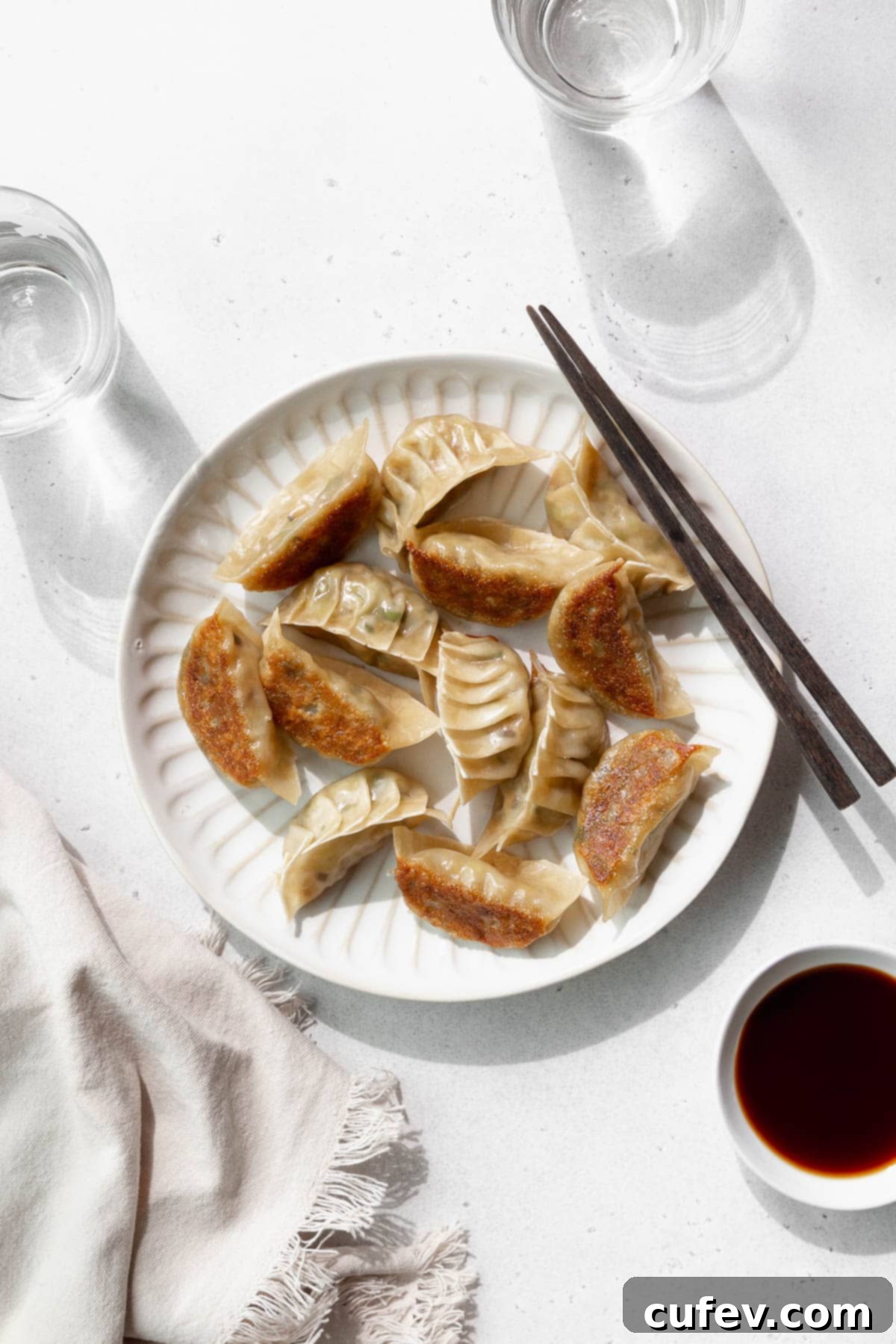
Table of contents
- What Are Gyoza? Unveiling the Beloved Japanese Dumpling
- Why You’ll Fall in Love with These Homemade Vegetable Gyoza
- Essential Ingredients for Perfect Vegan Gyoza
- Selecting the Best Gyoza Wrappers for Your Homemade Dumplings
- Crafting Your Own Delicious Vegetable Gyoza: A Step-by-Step Guide
- Mastering Homemade Gyoza: Essential Recipe Success Tips
- Delightful Serving Suggestions for Your Vegetable Gyoza
- Exciting Recipe Variations for Your Vegan Gyoza
- Preparing Your Vegan Gyoza in Advance: A Freezer-Friendly Guide
- Storing and Reheating Your Delicious Vegetable Gyoza
- Frequently Asked Questions About Vegetable Gyoza
- Explore More Delicious Vegan Japanese Recipes
What Are Gyoza? Unveiling the Beloved Japanese Dumpling
Gyoza (餃子) are a widely cherished type of Japanese dumpling, renowned for their delectable filling encased in a thin, pliable dough wrapper. Traditionally, these savory pockets are often prepared with a mixture of ground meat, finely chopped vegetables, and a medley of aromatic seasonings. However, this particular recipe proudly presents a sensational vegan gyoza version, meticulously crafted with an abundance of fresh, vibrant vegetables such as crisp cabbage, sweet onions, pungent green onions, and earthy mushrooms. This ensures a delightful plant-based experience without compromising on authentic Japanese flavors.
The preparation method of gyoza is what truly sets them apart and creates their signature texture. After the flavorful vegan filling is carefully enclosed within a delicate dough skin—much like its Chinese dumpling counterparts—the gyoza undergo a unique cooking process. They are first pan-fried until their bottoms achieve a beautiful golden-brown crispness, creating a satisfying crunch. Following this, a small amount of water is added to the pan, and the gyoza are quickly steamed, ensuring the filling is perfectly cooked through and the wrappers become tender yet resilient. This dual cooking technique results in a dumpling that is simultaneously crispy and tender, a culinary masterpiece.
In Japanese cuisine, homemade gyoza are incredibly versatile and can be enjoyed in various ways. They are frequently served as a delightful main course, a savory side dish, or an irresistible appetizer. The experience is often elevated by dipping them into a classic soy sauce blend or a zesty chili oil sauce, adding another layer of flavor. In traditional Japanese settings, these vegetable dumplings are commonly presented as part of a larger meal, accompanying steamed rice, a primary entrée, and a comforting bowl of soup. Their popularity transcends national borders, making them a beloved staple found in Japanese restaurants and grocery stores across the globe, appealing to diverse palates everywhere.
Why You’ll Fall in Love with These Homemade Vegetable Gyoza
While I could dedicate an entire essay to extolling the virtues of this incredible vegetable gyoza recipe, let’s distill it down to the most compelling reasons why these delightful dumplings are destined to become a firm favorite in your culinary repertoire:
- Unmatched Freshness and Wholesome Goodness. While the convenience of frozen gyoza is undeniable and they certainly have their place, nothing compares to the vibrant, full-bodied flavors of freshly prepared ingredients. This vegetarian gyoza recipe shines with the crisp sweetness of fresh cabbage, the deep umami of shiitake mushrooms, the subtle bite of green onions, and the aromatic warmth of freshly grated ginger and garlic. The harmonious blend of these fresh components elevates the taste profile far beyond any store-bought alternative, offering a truly healthy and invigorating meal.
- Impressively Elegant, Yet Effortlessly Achievable. Imagine presenting a beautifully arranged platter of these exquisite homemade vegan dumplings to your friends and family. The sheer visual appeal and irresistible aroma are guaranteed to elicit exclamations of delight. They are the perfect showstopper for any occasion, whether it’s an intimate dinner party, a bustling potluck, or an elegant cocktail gathering. Despite their sophisticated appearance, you’ll discover that crafting these gyoza at home is surprisingly straightforward, making you look like a culinary genius without excessive effort.
- A Deeply Rewarding and Enjoyable Culinary Process. While the recipe does involve a few distinct steps, the journey of making these dumplings from scratch is incredibly satisfying and meditative. From mincing the fresh vegetables to carefully folding each gyoza, there’s a therapeutic rhythm to the process. The anticipation builds with every dumpling you create, culminating in the immense gratification of tasting your own perfectly crafted comfort food. If you find joy in hands-on cooking and appreciate a rewarding outcome, this recipe is tailor-made for you.
- Naturally 100% Vegan and Vegetarian-Friendly. One of the greatest appeals of this recipe is its inherent plant-based nature. There’s no need for tricky substitutions or modifications to make it suitable for a vegan or vegetarian diet. Every ingredient is thoughtfully chosen to be entirely free of animal products, ensuring that everyone can enjoy these authentic Japanese flavors without compromise. This makes it an ideal choice for inclusive meal planning and catering to diverse dietary needs.

Essential Ingredients for Perfect Vegan Gyoza
Crafting truly delicious homemade vegetable gyoza begins with selecting high-quality, fresh ingredients. Here’s a detailed look at what you’ll need to create the savory, umami-rich filling and the delectable dipping sauce:
- Cabbage – The cornerstone of our filling! Green cabbage is highly recommended for its ideal texture and mild sweetness once cooked, providing a fantastic base. If green cabbage isn’t readily available, finely minced Napa cabbage can also be used as a suitable alternative, offering a slightly softer texture.
- Onion – For a foundational aromatic and a touch of sweetness, use either yellow or white onions. Mince them finely to ensure they blend seamlessly into the dumpling filling.
- Shiitake mushrooms – These mushrooms are crucial for adding a deep, earthy, and rich umami flavor that is characteristic of authentic Japanese cuisine. Make sure to chop the shiitake mushrooms very finely, ensuring they integrate perfectly with the other vegetables and contribute to a harmonious texture within the gyoza.
- Green onions – Also widely known as scallions, these contribute a distinctive fresh, grassy, and mildly pungent flavor. They provide a wonderful counterpoint to the richness of the mushrooms and cabbage, adding a layer of complexity to the overall taste of the gyoza.
- Fresh Ginger & Garlic – The importance of using fresh aromatics cannot be overstated. Freshly minced garlic and grated ginger are indispensable for infusing the filling with their vibrant, pungent, and warming flavors. Avoid powdered versions for the best, most authentic taste.
- Soy sauce – A fundamental ingredient in Japanese cooking, soy sauce imparts essential salty and savory umami notes, enhancing and deepening the overall flavor profile of the vegetable filling mixture. Opt for a good quality soy sauce for the best results.
- Vegan fish sauce – This is a fantastic secret ingredient for adding depth and that distinct savory “umami” kick without any animal products. My personal go-to is Nature’s Charm vegan fish sauce, which delivers exceptional flavor and a perfect balance of saltiness, making these dumplings truly sing while remaining 100% vegan.
- Vegetable stock paste – For an extra layer of savory depth and richness, a good quality vegetable stock paste works wonders. If you don’t have paste, readily available vegetable stock cubes or bouillon granules can be used interchangeably, dissolving easily into the filling mixture.
- Potato starch – Just a small amount, typically a teaspoon, of potato starch is vital. It acts as a binding agent, helping to hold the moist vegetarian dumpling filling together and prevent it from becoming watery, ensuring a cohesive and pleasant texture inside the gyoza.
- Gyoza wrappers – These thin, round dough wrappers are the vehicle for our delicious filling. Choosing the right type is important; refer to the dedicated section below for detailed tips on purchasing the best gyoza wrappers.
- Neutral Cooking Oil – For pan-frying the gyoza, a neutral-flavored oil with a high smoke point is ideal. Options like avocado oil or grapeseed oil are excellent choices. In a pinch, a light olive oil can also be used, though be mindful of its lower smoke point.
- Sesame oil – A drizzle of toasted sesame oil at the end of cooking is transformative. Its distinctive nutty and aromatic flavor adds a beautiful, rich finish to the perfectly steamed and crispy vegan Japanese dumplings, elevating their overall appeal.
- Fine sea salt – Beyond seasoning, fine sea salt plays a crucial role in the initial preparation of the cabbage. It helps to draw out excess moisture from the cabbage, a critical step to ensure the dumpling filling remains firm and flavorful, preventing a soggy outcome.
Selecting the Best Gyoza Wrappers for Your Homemade Dumplings
The quality of your gyoza wrappers significantly impacts the final texture and enjoyment of your homemade dumplings. Here are essential considerations to guide you when choosing and purchasing wrappers, ensuring your vegan gyoza turn out perfectly:
- Understanding Wrapper Types and Textures: Gyoza wrappers come in a delightful variety of shapes, sizes, and thicknesses. You might encounter round wrappers, which are the most common and ideal for traditional pleating, as well as square or rectangular ones, often used for other dumpling styles. Their texture can range from thicker and more substantial, offering a satisfying chew, to thinner and more delicate, resulting in a crispier finish. For this specific vegan dumpling recipe, I highly recommend opting for round wrappers that are moderately thick. These provide the perfect balance: sturdy enough to hold the generous vegetable filling without tearing, yet thin enough to achieve that desirable crispy bottom and tender steamed top.
- Prioritizing Freshness for Optimal Pliability: The freshness of your gyoza wrappers is paramount for ease of handling and a superior end product. Always seek out wrappers that appear fresh, moist, and pliable. Avoid any packages where the wrappers show signs of cracking, drying out, or sticking together excessively, as these will be difficult to work with and may tear during assembly. When scanning the refrigerated section, always check the expiration date and choose a package with the latest possible date to guarantee maximum freshness and flexibility for your dumpling-making session.
- Scrutinizing the Ingredient List for Wholesome Choices: For the healthiest and most authentic experience, it’s wise to review the ingredients list on the packaging. Aim for gyoza wrappers made with simple, wholesome ingredients. Typically, the best wrappers contain only flour, water, and salt. Be wary of lengthy ingredient lists that include numerous additives or preservatives, as these can sometimes affect the flavor and texture. Selecting wrappers with minimal, natural ingredients ensures you’re starting with the best possible foundation for your delicious vegetable gyoza.
You’ll often find excellent quality gyoza wrappers from reputable brands like Myojo and Shirakiku in the refrigerated section of most Asian grocery stores or even well-stocked conventional supermarkets. Don’t hesitate to explore these options to find the perfect wrapper for your culinary creation.

Crafting Your Own Delicious Vegetable Gyoza: A Step-by-Step Guide
While the intricate pleats of gyoza might make them appear challenging, rest assured that making these homemade vegan dumplings is actually a straightforward and incredibly rewarding process! Follow these simple steps to create perfect, crispy, and flavorful vegetable gyoza from scratch:
Step 1: Prepare the Cabbage for the Filling. Begin by placing your finely minced cabbage into a large mixing bowl. Generously sprinkle the fine sea salt evenly over the cabbage. Using your hands, thoroughly massage the salt into the cabbage. This crucial step helps to draw out excess moisture. Allow the salted cabbage to sit undisturbed for a full 15 minutes. This natural dehydration process is key to preventing a watery dumpling filling.
Step 2: Remove Excess Moisture. After the 15-minute resting period, gather the cabbage in your hands and firmly squeeze out as much water as possible. You’ll be surprised by how much liquid is released! Discard the squeezed liquid and return the now drier, more compact cabbage back into the large mixing bowl. This ensures a firm and flavorful filling.
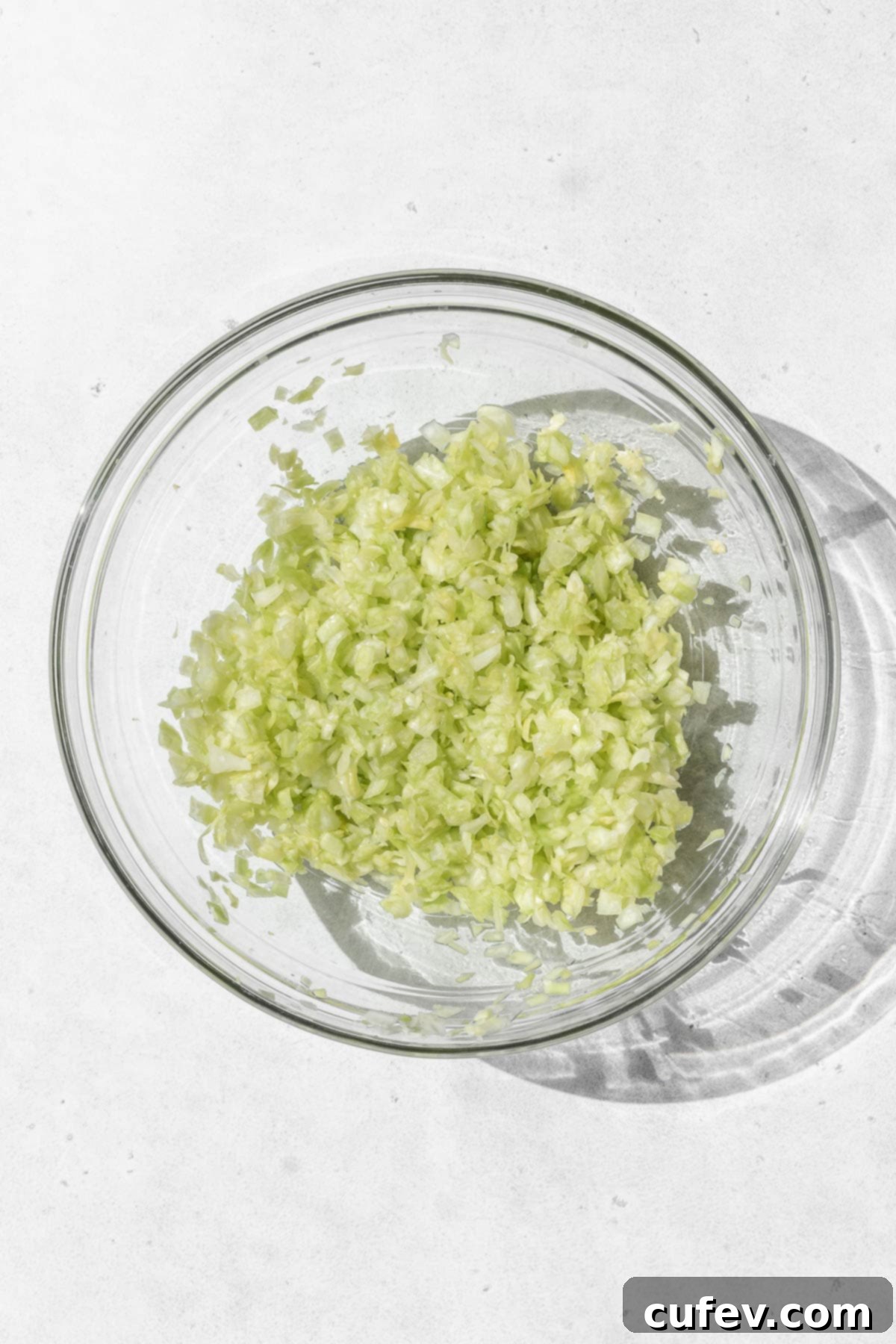
Step 3: Prepare and Combine the Filling Ingredients. Take your finely minced onion and spread it evenly on a microwave-safe plate. Microwave it for approximately 2 minutes, or until it has softened slightly and is partially cooked. This step helps to mellow the onion’s raw bite and integrate its flavor more smoothly. Add the microwaved onions to the cabbage in the bowl, along with the minced shiitake mushrooms, chopped green onions, freshly grated ginger, grated garlic, soy sauce, Nature’s Charm vegan fish sauce, vegetable stock paste (or a dissolved stock cube), and potato starch. Using your hands or a sturdy spoon, mix all the ingredients thoroughly until they are well combined and evenly distributed. Before proceeding, taste a small amount of the mixture and adjust seasoning with additional salt if needed, ensuring the filling is perfectly balanced.
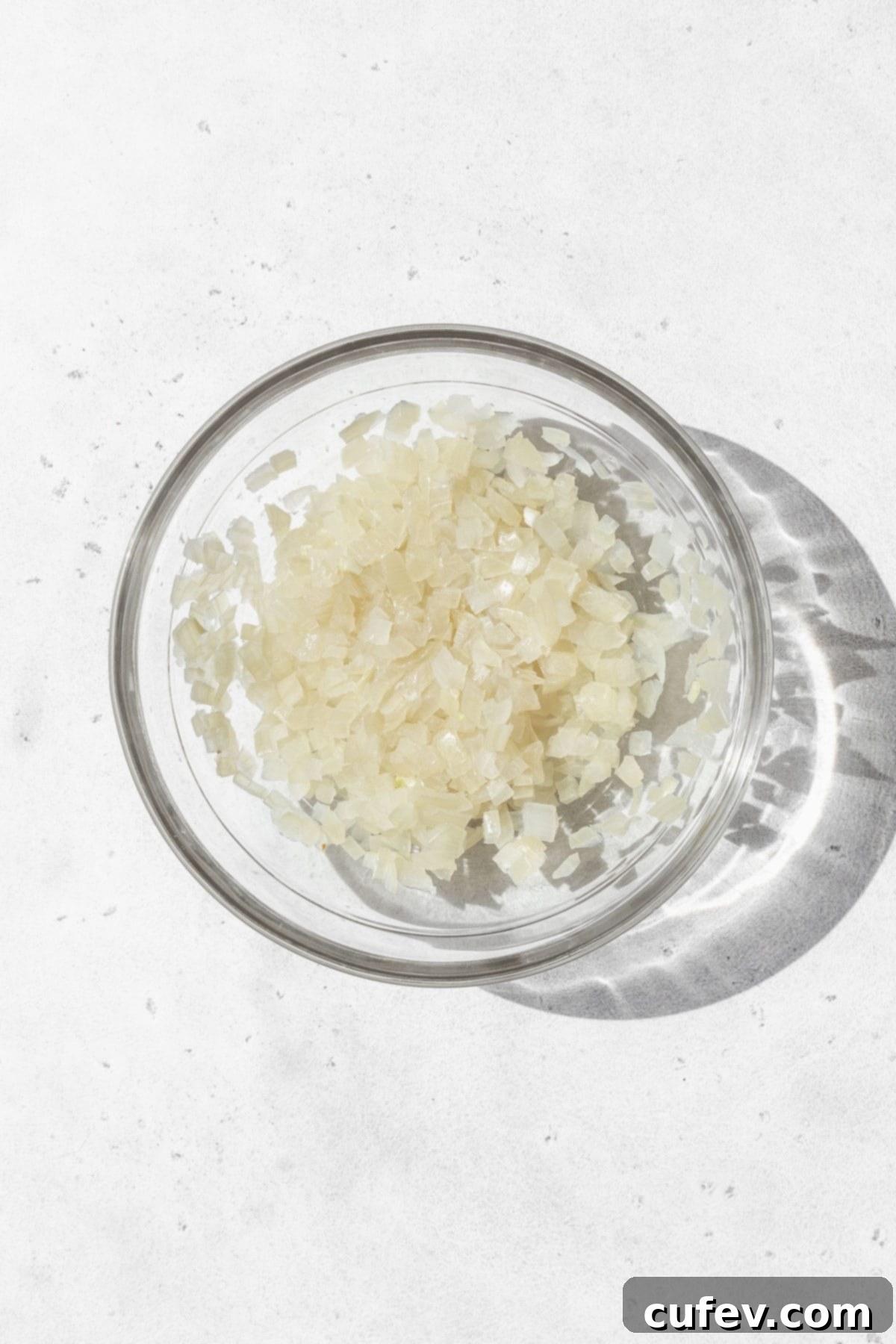


Step 4: Filling and Sealing Your Gyoza Wrappers. Take one gyoza wrapper and lay it flat on the palm of your hand. Place about 2 teaspoons of the prepared vegetable mixture directly in the center of the wrapper. Dip a finger in a small bowl of water and moisten the entire inner edge of the wrapper. Carefully fold the gyoza wrapper in half, bringing the edges together over the filling. Press the edges firmly to seal it shut, ensuring no gaps. For a more traditional and elegant presentation, you can create a beautiful pleated pattern along the sealed edge. This involves making small, overlapping folds on one side of the wrapper while pressing it against the other side. Practice makes perfect!
Step 5: Assemble All Dumplings. Continue the filling and sealing process, one wrapper at a time, until you have used up all your gyoza wrappers or all of the delicious vegetable filling. As you complete each gyoza, place it on a lightly floured surface or a parchment-lined baking sheet, ensuring they don’t touch each other to prevent sticking. You’ll soon have a beautiful batch of homemade vegetable gyoza ready for cooking!
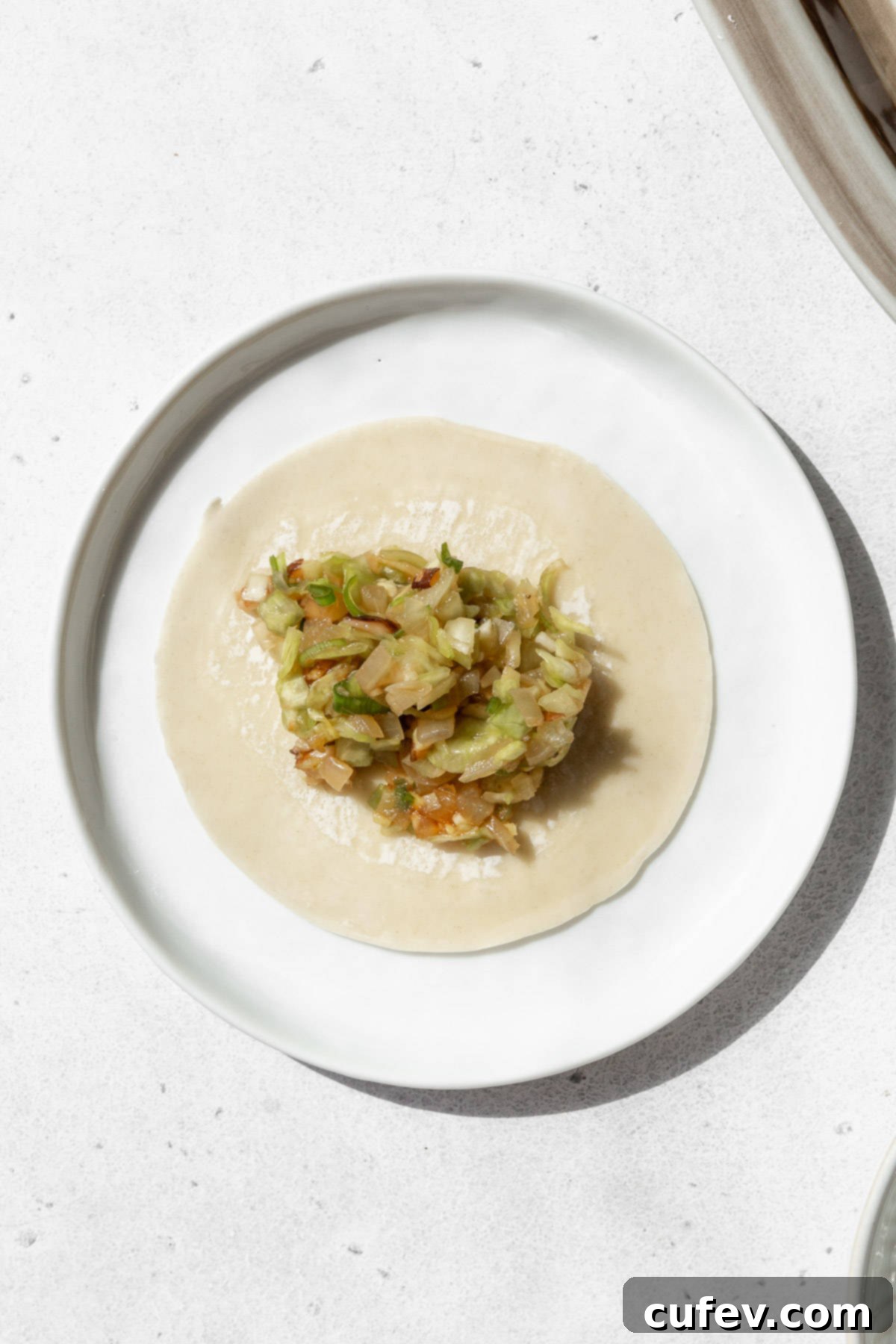

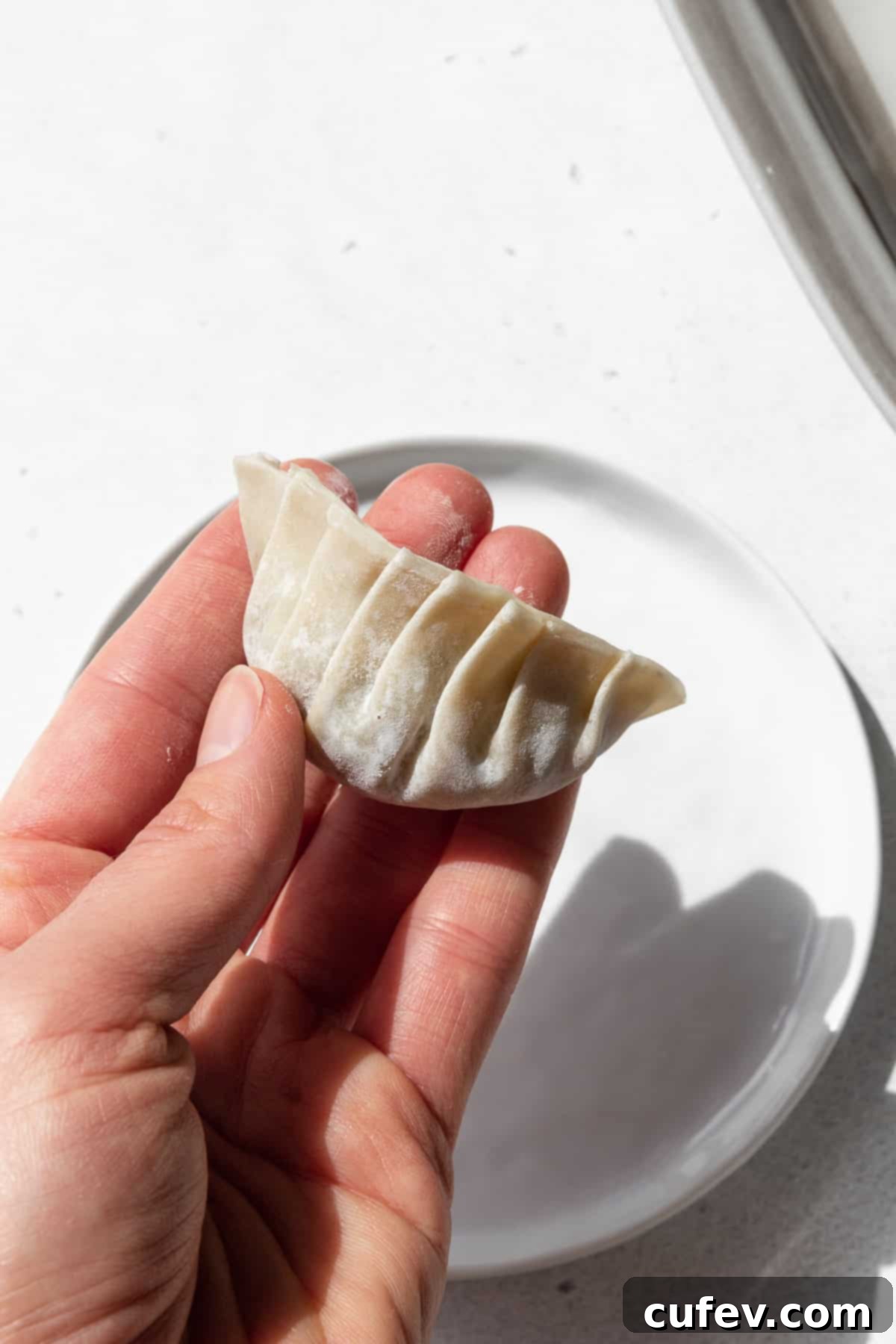
Step 6: Pan-Frying for a Crispy Bottom. Heat 1 tablespoon of neutral oil (like avocado or grapeseed) in a large non-stick frying pan over medium heat until shimmering. Carefully arrange the assembled vegetable gyoza in a single layer, flat-side down, in the hot pan. Ensure they are not overcrowded. Cook them for 2-3 minutes, or until their bottoms achieve a beautiful, enticing golden-brown and crispy texture. This is the hallmark of perfectly cooked gyoza!
Step 7: Steaming to Perfection. Once the bottoms are golden, carefully pour ¼ cup of water into the pan. Immediately cover the pan tightly with a lid. The water will create steam, which will cook the upper part of the gyoza filling and soften the wrappers. Allow the gyoza to steam for approximately 3-5 minutes, or until most of the water has evaporated and the wrappers appear translucent and cooked through.

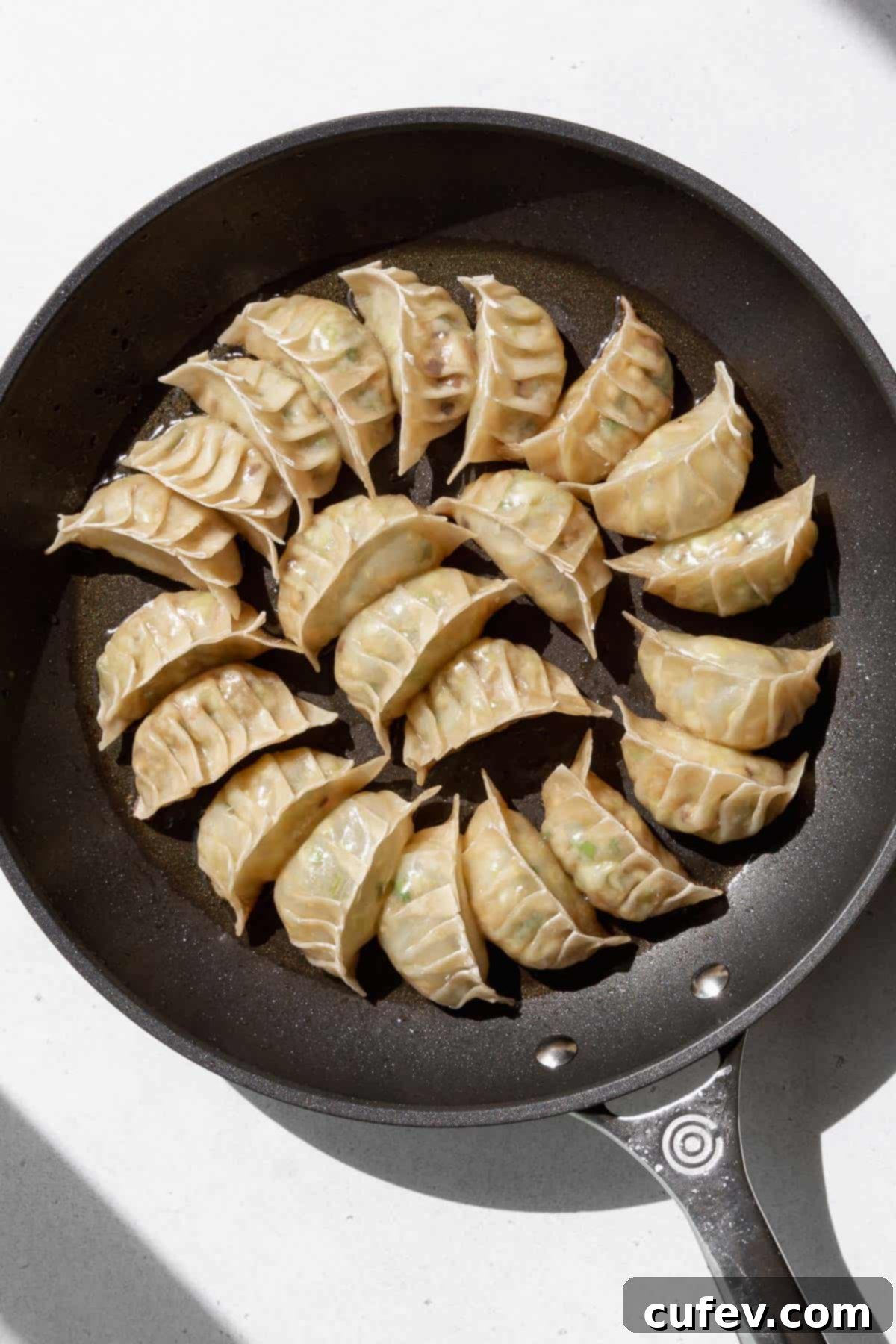
Step 8: Achieving the Final Crisp and Flavor Boost. Remove the lid from the pan and continue cooking for another minute or two, allowing any residual water to completely evaporate. This is where the magic happens for that extra crispy bottom! Once the water is gone, generously drizzle the cooked veggie gyoza with 1 tablespoon of aromatic sesame oil. Continue to cook for a short period, just until the bottoms achieve an even deeper golden hue and become extra crispy. Carefully transfer the hot gyoza from the pan onto a serving plate.
Step 9: Prepare and Serve with Dipping Sauce. While the gyoza are still hot, whisk together the ingredients for your dipping sauce in a small bowl. A simple blend of soy sauce, a dash of Nature’s Charm vegan fish sauce for extra depth, and a swirl of chili oil for an optional kick is classic and perfect. Serve your perfectly cooked, piping hot vegan gyoza immediately with this flavorful dipping sauce. Enjoy every savory, crispy bite! If you’re feeling adventurous and want to explore beyond traditional gyoza sauce, these dumplings also pair wonderfully with a vibrant homemade bang bang sauce for an exciting twist!
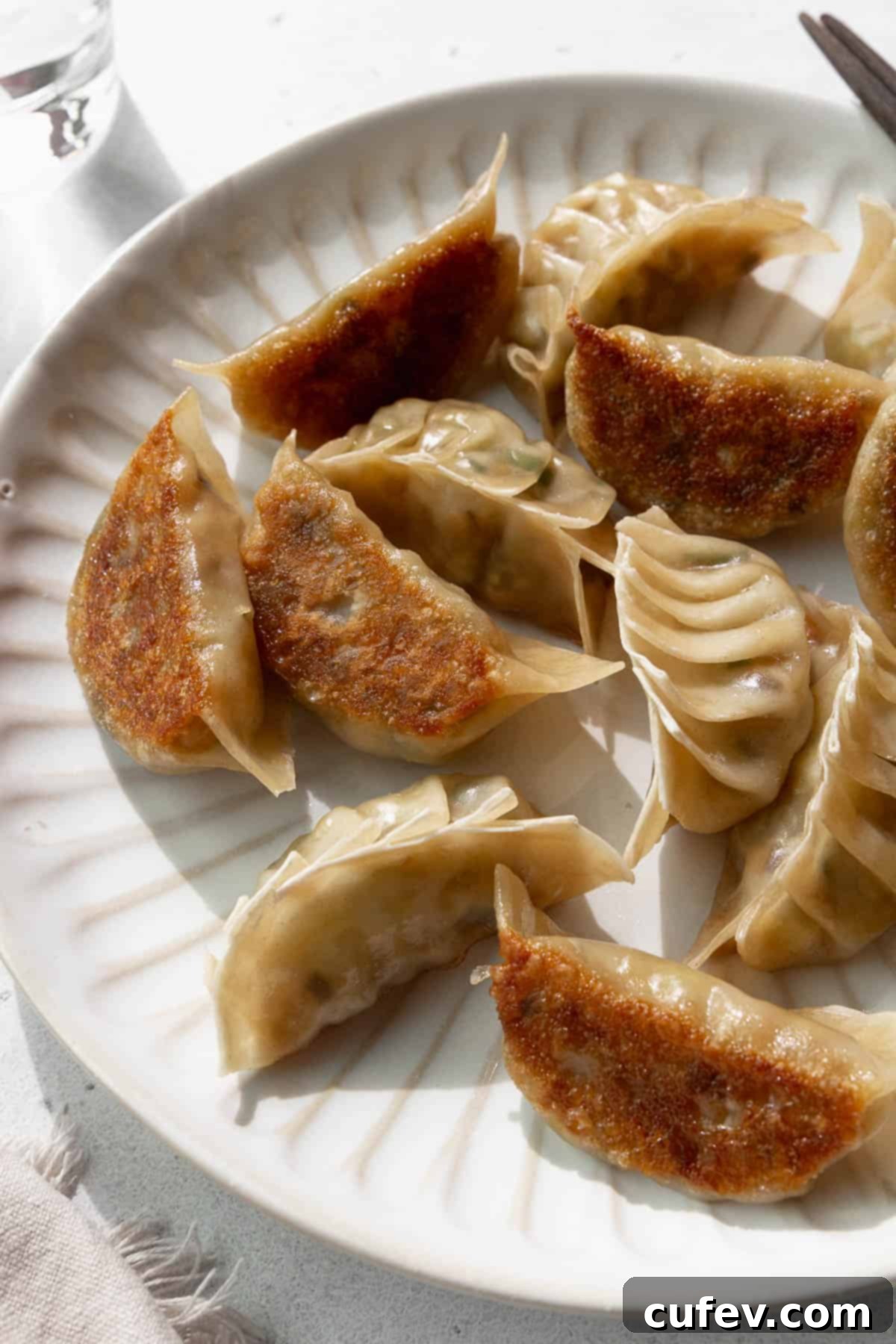
Mastering Homemade Gyoza: Essential Recipe Success Tips
Achieving perfectly crispy and flavorful homemade vegetable gyoza is easier with a few expert tips. Keep these in mind as you prepare your delicious vegan dumplings:
- Ensure Even Salt Distribution on Cabbage. When salting the minced cabbage, it’s crucial to sprinkle the salt as evenly as possible and then massage it thoroughly. This meticulous approach guarantees that the salt effectively draws out all excess moisture from every strand of cabbage. Removing this unnecessary water is vital for creating a firm, flavorful, and non-soggy vegetable gyoza filling, ensuring a superior texture and taste.
- Achieve Uniform Vegetable Mincing. For the best texture and flavor distribution, make sure to mince all your vegetables – cabbage, onions, shiitake mushrooms, and green onions – to a consistent, small size. Uniformly chopped ingredients allow the filling to mix together seamlessly, ensuring that every bite of your vegan dumpling is packed with a balanced and consistent flavor profile. It also aids in preventing wrappers from tearing.
- Always Taste and Adjust the Filling Before Wrapping. This is a golden rule in dumpling making! Before you begin the assembly process, always take a small pinch of your mixed vegetable filling and taste it. This allows you to check for seasoning and make any necessary adjustments, such as adding a bit more salt, soy sauce, or a dash of black pepper, to achieve your desired flavor balance. It’s far easier to adjust the seasoning now than after the gyoza are cooked.
- Expel Air Bubbles Before Sealing Each Gyoza. As you fill and fold each gyoza wrapper, pay close attention to pressing out any trapped air bubbles. Air pockets inside the dumplings can cause them to puff up excessively, and sometimes even burst or rupture during the cooking process, leading to a messy pan and less appealing gyoza. Gently squeeze out any air as you seal the edges completely shut.
- Invest in a Quality Non-Stick Frying Pan. A reliable non-stick frying pan is your best friend when cooking gyoza. Its surface prevents the delicate wrappers from sticking to the pan during the crucial initial pan-frying stage, ensuring that you achieve that coveted golden-brown, crispy bottom without tearing or leaving parts behind. This makes the cooking process smoother and the results consistently excellent for your Japanese dumplings.
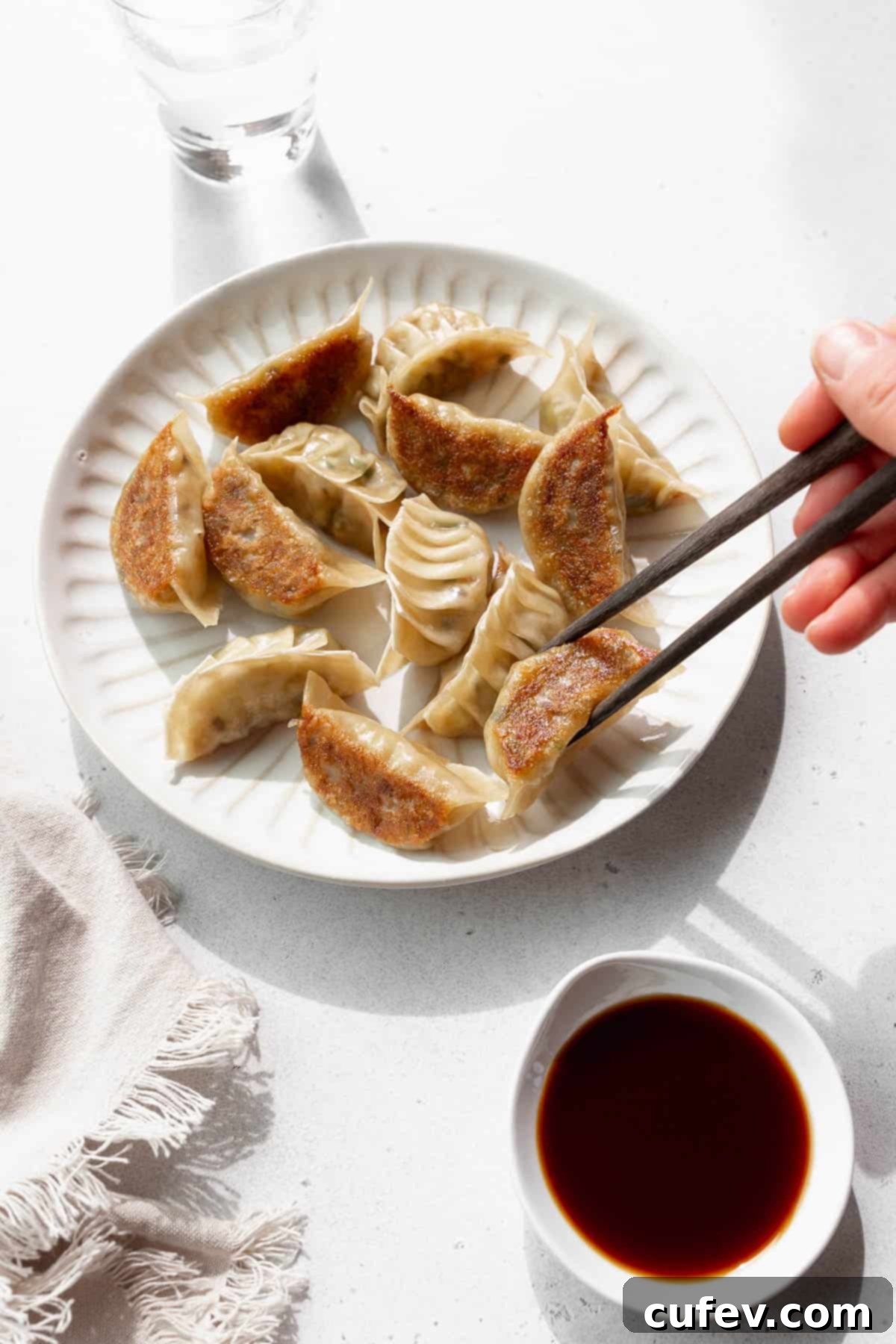
Delightful Serving Suggestions for Your Vegetable Gyoza
These versatile vegan dumplings are truly exceptional, making them a superb choice for a variety of culinary roles. They shine equally bright as a satisfying main dish, a flavorful side, or an irresistible appetizer. Around our home, they are a consistently popular choice for both quick lunches and hearty dinners!
For the ultimate experience, your homemade gyoza should always be served piping hot, straight from the skillet. Pair them with a classic dipping sauce—a simple blend of soy sauce, a dash of Nature’s Charm vegan fish sauce for extra depth, and a swirl of chili oil for an optional kick. To elevate their presentation and add a fresh burst of flavor, consider garnishing your plate of gyoza with thinly sliced fresh green onions and a sprinkle of toasted sesame seeds. The vibrant colors and textures make them even more appealing.
While the primary cooking method detailed in our recipe card involves the popular pan-fry and steam technique for that signature crispy bottom, don’t hesitate to explore other traditional ways to enjoy these delicious Japanese dumplings:
- Sui Gyoza (Water Gyoza): For a lighter, softer texture, you can boil the gyoza directly in a pot of simmering water until they float and are cooked through. These “water gyoza” are wonderfully comforting and are typically served with the same savory dipping sauce on the side, allowing the delicate flavor of the filling to truly shine.
- Soup Gyoza: Elevate your gyoza experience by cooking them directly in a flavorful vegetable stock or broth. This creates a wholesome and warming “soup gyoza,” turning them into a comforting meal on a chilly day. You can add extra vegetables to the broth for a more substantial soup, making it a complete and nourishing dish.
Experiment with these serving styles to find your favorite way to enjoy these incredibly adaptable and delicious vegetarian gyoza!
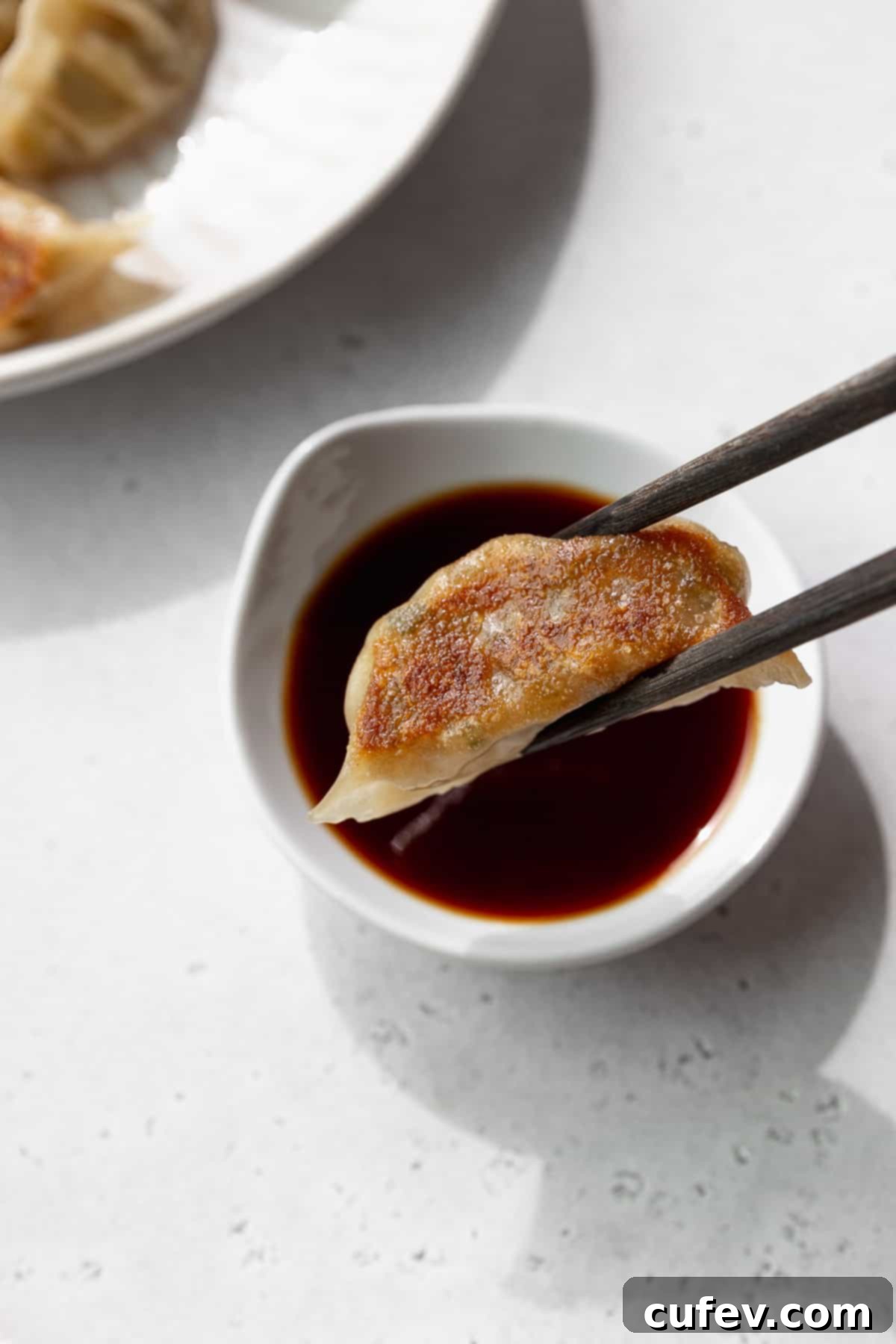
Exciting Recipe Variations for Your Vegan Gyoza
One of the beauties of making homemade vegetable gyoza is the flexibility to customize them to your personal taste and what you have on hand. Here are some fantastic variations to inspire your culinary creativity:
- Diversify Your Vegetable Blend: Feel free to experiment beyond the core vegetables! While green cabbage and shiitake mushrooms are classic, a variety of other chopped mushrooms can lend their unique flavors and textures. Consider adding finely chopped cremini (baby bella) mushrooms for a richer, more robust flavor, or delicate oyster mushrooms for an interesting textural contrast. In terms of cabbage, if you’re looking for a slightly different character, Napa cabbage can offer a sweeter, softer bite, while a small amount of finely shredded red cabbage can introduce a vibrant color and subtle peppery note to the filling. Remember to still salt and drain any high-moisture vegetables.
- Amp Up the Spice Factor: For those who appreciate a fiery kick, it’s easy to infuse more heat into your vegan dumplings. You can directly stir chili oil or a generous pinch of red pepper flakes into the vegetable filling mixture to taste, distributing the warmth throughout each gyoza. Alternatively, for a more controlled heat, you can simply increase the amount of chili oil in your dipping sauce, allowing each diner to customize their spice level with every delicious dip. A touch of Sriracha or gochujang could also be incorporated into the filling for a different kind of heat.
- Herb and Aromatic Enhancements: Don’t be shy about playing with other fresh herbs and aromatics. A sprinkle of fresh cilantro or finely chopped chives in the filling can add a bright, fresh dimension. A hint of toasted sesame seeds or a tiny dash of grated lemon zest could also surprisingly brighten the flavor profile of your vegetarian gyoza.

Preparing Your Vegan Gyoza in Advance: A Freezer-Friendly Guide
One of the most convenient aspects of homemade vegetable gyoza is how incredibly freezer-friendly they are, making them a perfect make-ahead option for busy weeks or spontaneous cravings. This makes them a fantastic vegan freezer recipe to have stocked!
To prepare your gyoza for future enjoyment, simply follow the assembly steps (Steps 1-5 above). Once your vegan dumplings are freshly assembled, arrange them in a single layer on a baking sheet that has been lined with parchment paper. Ensure there’s a small space between each dumpling to prevent them from sticking together. Place the baking sheet in the freezer and freeze until the dumplings are completely solid. This usually takes about 1-2 hours, depending on your freezer’s efficiency. Once they are rock-solid, carefully transfer the frozen dumplings into a heavy-duty, freezer-safe airtight container or a resealable freezer bag. They can be safely stored in the freezer for up to 3 months, ready to be cooked whenever you desire a quick, delicious meal.
When you’re ready to cook your gyoza from their frozen state, there’s no need to thaw them! Simply proceed with the pan-frying and steaming steps as outlined in the main recipe. However, you will need to adjust the cooking time slightly. Add an additional 1 to 2 minutes to the steaming step to ensure the gyoza are thoroughly cooked through and reach a steaming hot internal temperature. The crispiness of the bottom will still be achievable, giving you perfectly cooked, delicious Japanese dumplings on demand.
Storing and Reheating Your Delicious Vegetable Gyoza
Should you find yourself with any delectable leftover veggie dumplings (a rare occurrence, we know!), proper storage and reheating are key to maintaining their deliciousness. Cooked gyoza can be stored in an airtight container in the refrigerator for 4-5 days. Make sure they are cooled completely before transferring them to the container to prevent condensation and sogginess.
When it comes to reheating, you have a couple of excellent options to bring your homemade gyoza back to life:
- Microwave Method: For a quick and easy reheat, place the leftover gyoza on a microwave-safe plate. Heat them on high for 1-2 minutes, or until they are thoroughly warm. While this method is fast, it tends to make the wrappers softer rather than crispy.
- Pan-Frying Method (Recommended for Crispiness): To recapture that desirable crispy bottom, the best method is to pan-fry them again. Heat a small amount of neutral oil in a non-stick skillet over medium-high heat. Once the oil is shimmering, add the leftover gyoza and cook for a few minutes on each side, or until they are heated through and the bottoms are golden and crispy once more. This method truly brings out the best in your reheated Japanese dumplings.
Enjoy your delicious leftovers!
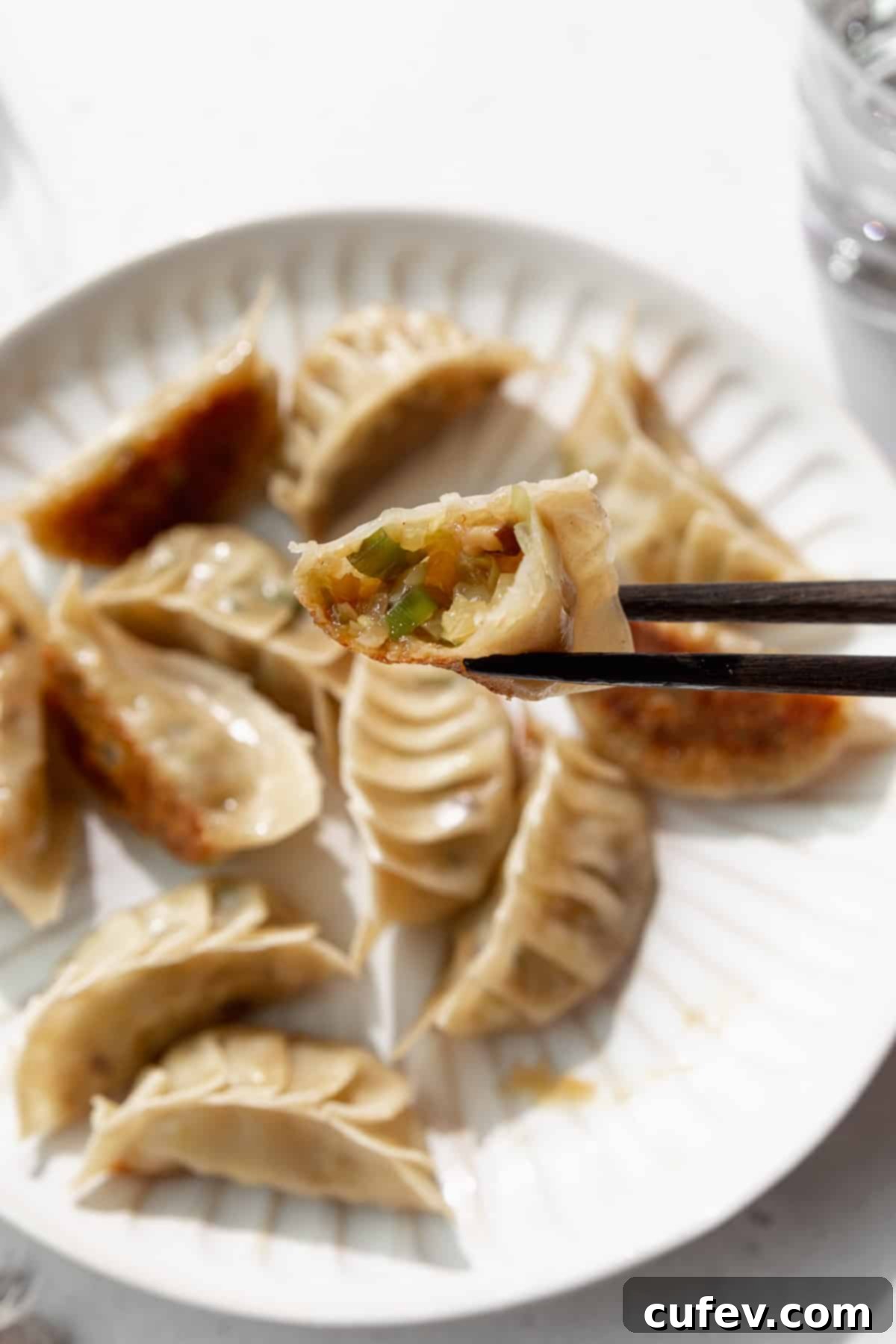
Frequently Asked Questions About Vegetable Gyoza
The terms “gyoza” and “dumplings” are often used interchangeably, but there’s a nuanced distinction. “Dumpling” is a much broader culinary category, encompassing a vast array of filled dough pockets enjoyed across various cultures, particularly throughout Asia. This includes everything from Chinese jiaozi and Korean mandu to Polish pierogi. Gyoza, on the other hand, specifically refers to the Japanese variety of these delectable filled parcels. While they share similarities with Chinese jiaozi (from which they originated), Japanese gyoza typically have thinner wrappers, a more finely minced filling, and a characteristic preparation method that involves both pan-frying for a crispy bottom and steaming for a tender top. So, while all gyoza are dumplings, not all dumplings are gyoza.
Absolutely! While many traditional gyoza recipes do incorporate animal products such as ground meats (like chicken or pork) or animal-based broths, vegans can most certainly enjoy gyoza. The key is to select or prepare vegetable gyoza, like the delicious recipe shared here, that are specifically made with 100% plant-based ingredients. This means ensuring the filling contains only vegetables, and that no animal-derived components like chicken broth, fish sauce (unless it’s a vegan alternative like Nature’s Charm!), or egg-based wrappers are used. Always check ingredient lists carefully when purchasing, or better yet, make your own at home to guarantee they are entirely vegan-friendly.
While I am not a registered dietitian or medical professional and cannot offer definitive health claims, veg gyoza, particularly this homemade version, can be a wonderful and nutritious addition to a balanced diet. They are generously packed with a variety of fresh vegetables, providing essential vitamins, minerals, and dietary fiber. The cooking method, which involves minimal oil for pan-frying followed by steaming, means they are not deep-fried, keeping the fat content relatively low. As a fiber-rich meal, they are satisfying and a delicious way to significantly boost your daily vegetable intake. Pairing them with a light soup or a fresh salad can create an even more wholesome and complete meal.
To prevent gyoza wrappers from tearing, start by ensuring they are fresh and pliable. Avoid wrappers that appear dry or cracked. When working with them, keep any unused wrappers covered with a damp cloth or plastic wrap to prevent them from drying out. When filling, don’t overfill the wrapper; about 2 teaspoons is usually sufficient. Be gentle when handling and folding, and ensure the edges are properly moistened with water before sealing to create a strong bond. Gently press out any air before sealing completely.
While the traditional pan-fry and steam method yields the best crispy-bottom, tender-top texture, you can certainly experiment with baking or air-frying for a different result. To bake, lightly brush the gyoza with oil and bake at 375°F (190°C) for 15-20 minutes, flipping halfway, until golden. For air-frying, lightly brush with oil and air-fry at 375°F (190°C) for 8-12 minutes, shaking the basket occasionally, until crispy and cooked through. Note that these methods will result in an all-over crispy dumpling rather than the distinct crispy bottom and steamed top of the traditional method.
Explore More Delicious Vegan Japanese Recipes
If you’ve enjoyed the delightful experience of making these homemade vegetable gyoza and are eager to delve deeper into the rich and diverse world of Japanese plant-based cuisine, here are some other fantastic recipes from our collection you might love:
- For a truly hearty and satisfying dinner, don’t miss our incredible Vegan Japanese Curry. This deeply flavorful and comforting dish is perfectly complemented by crunchy vegan katsu cutlets and a side of fluffy hot rice, creating a complete and nourishing meal.
- Discover a surprisingly beloved Japanese comfort food with our Vegan Macaroni Gratin. While a gratin might seem like an unexpected addition to Japanese cuisine, this creamy, baked dish featuring cooked macaroni, perfectly sautéed vegetables, and a rich, dairy-free béchamel sauce, topped with a golden, bubbly vegan cheese, is pure culinary bliss. It’s a testament to Japan’s ability to adapt and perfect dishes from around the world.
- Warm your soul on a chilly day with this wonderfully simple yet profoundly flavorful Vegan Japanese Cream Stew. It’s incredibly easy to prepare and yields a rich, comforting stew that pairs exquisitely with warm, crusty bread, offering a delightful and wholesome dining experience.
- No Japanese meal is complete without a sweet finish! If you’re craving a delightful Japanese dessert to serve after your gyoza, explore these delicious vegan options: a bright and zesty yuzu cheesecake, traditional and charming kashiwa mochi, delicate and chewy shiratama dango, or the ever-popular, sweet, and fruity strawberry mochi (Ichigo Daifuku). Each offers a unique taste of Japan’s confectionery artistry.
Thank you immensely for joining me on this culinary adventure and exploring the wonderful world of homemade vegetable gyoza! I sincerely hope you’ve enjoyed discovering and perhaps even making this delightful vegan dumpling recipe as much as I adore sharing it. These crispy, savory pockets truly are a joy to create and an absolute pleasure to devour. If you’re consistently on the hunt for more mouth-watering vegan, vegetarian, or dairy-free dinner inspiration, delicious plant-based recipes, and culinary tips, I invite you to connect with our vibrant community! Make sure to follow us on Pinterest, Facebook, and Instagram for daily updates and fresh content. Additionally, to ensure you never miss out on our newest recipes and exclusive insights, consider signing up for our email newsletter. We promise a spam-free inbox, filled only with delicious inspiration straight to you! Happy cooking!

Vegetable Gyoza
Print
Pin
Rate
Ingredients
Vegetable gyoza
- 2 cups cabbage, minced
- 1 medium onion, minced
- ½ teaspoon fine salt
- ⅓ cup minced shiitake mushrooms
- ½ cup minced green onions
- 1 teaspoon grated ginger
- 1 teaspoon grated garlic
- 1 teaspoon soy sauce
- 1 teaspoon Nature’s Charm vegan fish sauce
- 1 teaspoon vegetable stock paste or 1 vegetable stock cube
- 1 teaspoon potato starch
- 20 gyoza wrappers
- 1 tablespoon oil
- ¼ cup water
- 1 tablespoon sesame oil
Dipping sauce
- 2 teaspoons soy sauce
- 1 tablespoon Nature’s Charm vegan fish sauce
- chili oil optional
Instructions
-
Combine minced cabbage and fine sea salt in a large bowl, massage well, and let sit for 15 minutes. Firmly squeeze out all excess water from the cabbage and return it to the bowl.
-
Microwave minced onion for 2 minutes until softened. Add the softened onion to the cabbage along with minced mushrooms, green onions, ginger, garlic, soy sauce, Nature’s Charm vegan fish sauce, vegetable stock paste, and potato starch. Mix thoroughly and taste for seasoning, adjusting salt if necessary.
-
Place 2 teaspoons of filling on a gyoza wrapper. Moisten the inner edges with water, then fold in half and seal by pressing or pleating. Repeat this process until all filling or wrappers are used.
-
Heat 1 tablespoon of neutral oil in a large non-stick frying pan over medium heat. Place gyoza flat-side down and cook until bottoms are golden. Pour ¼ cup of water into the pan and immediately cover with a lid to steam for 3-5 minutes.
-
Remove the lid and allow any remaining water to evaporate. Drizzle the gyoza with 1 tablespoon sesame oil and continue cooking until the bottoms become extra crispy. Transfer the cooked gyoza to a plate.
-
Whisk together the dipping sauce ingredients in a small bowl and serve immediately with the hot gyoza.
Notes
- Leftover dumplings keep covered in the refrigerator for 4-5 days. Reheat them in the microwave on high for 1-2 minutes or pan-fry the gyoza in a non-stick skillet over medium-high heat with a small amount of oil.
